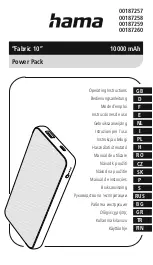
English |
23
Bosch Power Tools
1 609 92A 0B3 | (30.4.14)
1 – 2
low speed
3 – 4
medium speed
5 – 6
high speed
The values shown in the chart are standard values. The neces-
sary speed depends on the material and the operating condi-
tions, and can be determined by practical testing.
After longer periods of working at low speed, allow the ma-
chine to cool down by running it for approx. 3 minutes at max-
imum speed with no load.
Switching On and Off
Adjust the depth-of-cut before switching on or off; see Sec-
tion “Adjusting the Depth-of-cut”.
To
start
the machine, press the On/Off switch
20
and keep it
pressed.
To lock the
pressed
On/Off switch
20
, press the lock-on but-
ton
19
.
To
switch off
the machine, release the On/Off switch
20
or
when it is locked with the lock-on button
19
, briefly press the
On/Off switch
20
and then release it.
To save energy, only switch the power tool on when using it.
Constant Electronic Control
Constant electronic control holds the speed constant at no-
load and under load, and ensures uniform working perfor-
mance.
Soft Starting
The electronic soft starting feature limits the torque upon
switching on and increases the working life of the motor.
Adjusting the Depth-of-cut
The adjustment of the depth-of-cut may only be carried
out when the router is switched off.
Adjusting the Depth-of-cut on the Plunge Base
(see figure G)
For coarse adjustment of the depth-of-cut, proceed as fol-
lows:
– Place the machine with the router bit mounted on the
workpiece to be machined.
– Set the scale for fine adjustment
6
to
“0”
.
– Set the turret stop
12
to the lowest setting; the turret stop
can be felt to engage.
– Loosen the knurled screw at depth stop
16
, so that the
depth stop
11
moves freely.
– Press the release lever for plunge action
7
down and slowly
guide the router down until the router bit
18
touches the
workpiece surface. Let go of release lever
7
again to lock
this plunging depth.
– Push the depth stop
11
down until it faces against the tur-
ret stop
12
. Set the slide with the index mark
10
to the “0”
position on the scale for depth-of-cut adjustment
9
.
– Set the depth stop
11
to the desired routing depth and
tighten the knurled screw
16
for the depth stop. Take care
not to misadjust the slide with the index mark
10
.
– Press the release lever for plunge action
7
and guide the
router to the uppermost position.
The set routing depth is only reached when depth stop
11
touches the turret stop
12
while plunging.
For deep cuts, it is recommended to carry out several cuts,
each with little material removal. By using the turret stop
12
,
the cutting process can be divided into several steps. For this,
adjust the desired depth-of-cut to the lowest step of the turret
stop and select the higher steps first for the initial cuts. The
clearance of the steps is approx. 3.2 mm.
After a trial cut, the depth-of-cut can be set exactly to the de-
sired measure by turning the adjustment knob
5
; turn in
clockwise direction to increase the cutting depth and in anti-
clockwise direction to decrease the cutting depth. The scale
6
can be used for guidance. One full turn corresponds with a
setting range of 1.5 mm; a graduation mark on the top edge of
the scale
6
corresponds with a 0.1 mm change of the setting
range. The maximum setting range is ± 16 mm.
Example:
The desired depth-of-cut is to be 10.0 mm; the trial
cut resulted in a cutting depth of 9.6 mm.
– Press the release lever for plunge action
7
and guide the
router to the uppermost position.
– Turn adjustment knob
5
by 0.4 mm/4 graduation marks
(difference from nominal to actual value) in clockwise di-
rection.
– Check the selected depth-of-cut by carrying out another
trial cut.
When fine-adjusting the routing depth, take care that the in-
dex mark
8
on the side of the plunge base points towards the
centre imprinted line. This measure ensures that there is suf-
ficient travel in both directions for readjustment of the plunge
depth.
When the plunge base
2
is lowered to the maximal plunge
depth, cutting deeper by means of the fine adjustment is not
possible, as the maximum travel has been utilised.
Fine adjustment is also not possible when the depth stop
11
faces against the turret stop
12
.
Adjusting the Depth-of-cut on the Non-plunge Base
(see figure H)
For adjustment of the depth-of-cut, proceed as follows:
– Open the clamping lever for the non-plunge base
22
.
– Coarse pre-adjustment of the routing depth is possible in 3
steps. For this, press clamping lever
25
and slide the rout-
ing motor
1
up or down in the non-plunge base
3
, until it,
Material
Router bit diameter
(mm)
Thumb-
wheel 15
Hardwood (Beech)
4 – 10
12 – 20
22 – 40
5 – 6
3 – 4
1 – 2
Softwood (Pine)
4 – 10
12 – 20
22 – 40
5 – 6
3 – 6
1 – 3
Particle Board
4 – 10
12 – 20
22 – 40
3 – 6
2 – 4
1 – 3
Plastics
4 – 15
16 – 40
2 – 3
1 – 2
Aluminium
4 – 15
16 – 40
1 – 2
1
OBJ_BUCH-1178-004.book Page 23 Wednesday, April 30, 2014 10:24 AM
















































